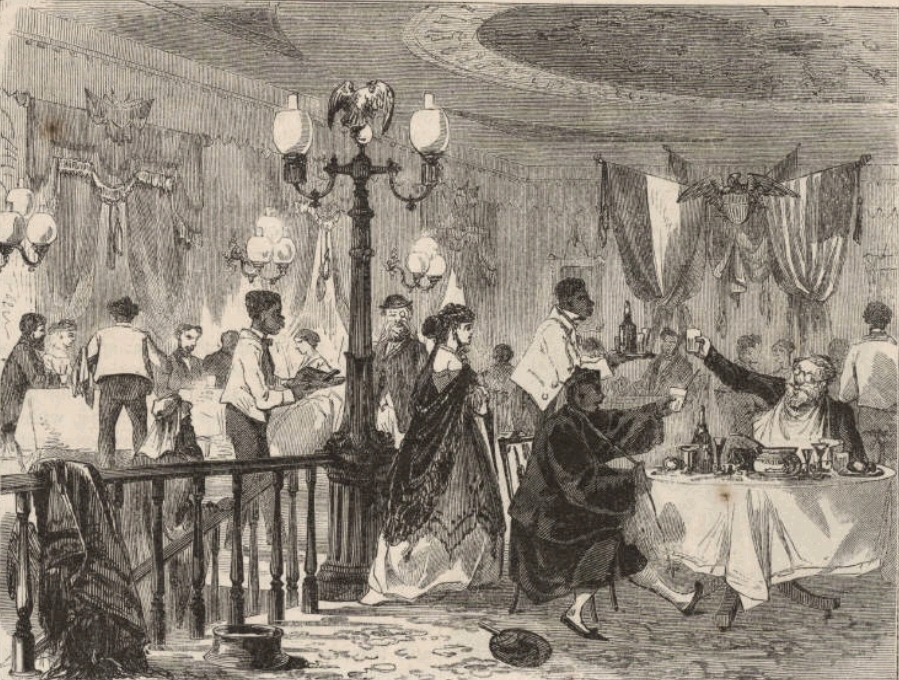Share This:
March 20, 2012 | Theatre,
Café Culture History, Part 2: Café Culture and the Age of Enlightenment
By Magda Romanska
The first American coffee house opened in Boston in 1676. Right away, beginning in the late seventeenth century, coffee houses in Boston and New York served as auction houses for commodities and real estate. Beginning in 1729, a coffee house was located next to the Merchants Exchange in New York, and in 1752 the newly erected Exchange building also hosted the Exchange Coffee Room. Another famous New York Merchants’ Coffee House was located at the end of Wall Street near the market square where African slaves and European indentured servants were customarily sold at the auctions. During the American Revolution, the function of the coffee houses changed as they became political meeting and planning places for the American Revolutionaries.

In Paris, the first coffee house was opened in 1672 by the same Pasqua Rose who brought coffee to London. His monopoly on the Paris coffee house business lasted until 1694 when Café Procope opened. Located on rue de l’Ancienne Comédie, in Paris’s 6th arrondissement, Café Procope is considered to be the oldest coffeehouse in Paris in continuous operation. When in 1689 the Comédie française was moved across the street, Café Procope became known as the “theatrical” café. Throughout the first half of the eighteenth century, the Procope served as the favorite gathering place for the members of the French Enlightenment with Rousseau, Voltaire and Diderot as its regular guests. Procope’s other famous patrons included Benjamin Franklin and Thomas Jefferson. It has been suggested that the Café Procope was the unofficial birthplace of the Encyclopedié, the first modern encyclopedia and the Enlightenment’s most conspicuous accomplishment.
As a result of the upper class flight to salons from the cafés, beginning in the mid-nineteenth century, Parisian coffee houses became gathering places for what contemporary American philosopher Michael Warner calls “subaltern counterpublics” – members of marginal groups: artistic and literary bohemians, sexual pariahs, and those operating on the borders of legality. Spending their times in coffee houses—often to escape their unheated apartments—many painters and writers of the era depicted the complex and seductive café life in their artworks and novels. In 1870s, for example, both Edgar Degas and Edouard Manet made a series of drawings and sketches of Parisian café night life, illustrating all of its multilayered glory, from its glamor, decadence and allure to the fundamental isolation of its many lone attendees looking to connect. In fact, during the period of the late nineteenth to early twentieth century, the Parisian coffee house culture became a primary subject for the newly emerging Impressionists, including Henri de Toulouse-Lautrec, Auguste Renoir, Vincent Van Gogh and Paul Gauguin.

Jürgen Habermas, the twentieth century German philosopher and sociologist, argues that the French coffee houses “in their golden age between 1680 and 1730 were centers of criticism – literary at first, then also political, in which began to emerge, between aristocratic society and bourgeois intellectual, a certain parity of the educated” (32). Beginning in the 1770s, however, Habermas suggests, the social, intellectual and political role heretofore fulfilled by coffee houses was slowly taken up by the salons. The image of the late-eighteenth-century Parisian coffee houses as the natural milieu of Paris’s upper echelons has been conjured largely by their fictional depictions in art and literature. The fact is that at the time, the influential members of the Parisian elites already preferred to hold their weekly gatherings in the privacy and safety of their own homes. Habermas suggests that the parity of the educated that once flourished inside the French coffee houses became increasingly absorbed by the forces of the emerging modern capitalist market state. The institution of weekly salons became an arm of the high-brow establishment, an occasion when attendees would discuss art, literature, and science as an afterthought to more important business and political conversations.



Coffee houses continued to be the center of Parisian artistic life until War World II. In the 1930s there were a reported eight hundred cafés in France, or one café for everyfifty people. After the war, Paris cafés once again became places of political and philosophical debates, with Jean-Paul Sartre, the father of French existentialism, being one of the most famous café attendee of the era. By the 1960s, however, the French coffee houses became dominated by disgruntled youths (since the cafés didn’t serve any alcohol, they naturally appealed to the underage crowds). As a result, Parisian cafés have lost some of their former intellectual and artistic cachet. Nonetheless, public records indicate that as late as 1967, Paris had 13,977 sidewalk cafés.
Image 1: The Cafés of the Paris Exhibition: The American Café (1886)
Image 2: At Café Procope: at rear, from left to right: Condorcet, La Harpe, Voltaire and Diderot
Image 3: Edgar Degas, At the Café, 1877
Image 4: Pierre Auguste Renoir, At the Café, 1977
Image 5: Paul Gaugin, Night Café at Arles, 1888
Image 6: Vincent Van Gogh, Café Terrace at Night, 1888
Image 7: Photograph at cafe with Nina Auzias, Leo Stein, and others, 1910

Images courtesy of Google, theYale Beinecke Library and the Harvard Via Collection





Leave a Reply